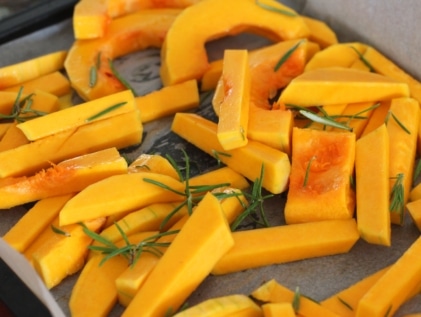As summer fades to a distant memory, thoughts turn to those beautiful, temperate fall days and all that entails—back to school, Friday night football, leaf peeping, apple picking, and maybe most of all, those delicious fall veggies – like butternut squash – that combine so many satisfying flavors with nutrition.
Squash is among the oldest known crops, dating back 10,000 years to Mexico and Central America. The name squash comes from the Native American word askutasquash, which means “uncooked or eaten raw.”
Next to pumpkin, butternut squash is possibly one of the most familiar of fall veggies. Its hard skin and peculiar, bulbous shape may be off-putting to some, and some believe it’s too sugary or starchy to be good for you. But don’t let either of those things deter you. Butternut squash is a nutritional powerhouse of essential vitamins, minerals, and antioxidants. It adds flavor to meals while being low in calories and high in fiber.
Nutritional Notes
Just one cup of cooked butternut squash provides:
- Calories: 82
- Carbs: 22 grams
- Fiber: 7 grams (May help keep your weight in balance and lower your cancer risk, colorectal cancer, in particular.)
- Vitamin A: 457% of the Reference Daily Intake (Essential for vision health, may reduce risk of breast cancer and may reduce the rate of memory loss in older adults.)
- Vitamin C: 52% of the RDI (Needed for immune function, collagen synthesis, wound healing, and tissue repair.)
- Vitamin E: 13% of the RDI (Protects against free radical damage and may reduce risk of age-related conditions, such as Alzheimer’s disease.)
- Thiamine (B1): 10% of the RDI (Plays a vital role in the growth and function of various cells.)
- Niacin (B3): 10% of the RDI (It can also reduce the risk of heart attack and slow narrowing of the arteries.)
How to Cook It
So, how best to incorporate butternut squash into your diet? Don’t be intimidated by butternut squash’s thick, tough skin when peeling. Here are a few tips to make it a bit easier:
- Cut a thin slice off the bottom and top so the squash will stand flat on a cutting board. Use a knife or peeler to slice the skin off from top to bottom. Always cut away from your body.
- If the skin is too tough to manage, pierce the squash a few times with a fork and put it in the microwave for a minute or two. This will soften the skin and make it easier to peel.
- Cut it in half and bake the squash with the skin on. It will easily peel away after it’s done cooking.
After peeling, cut in half the long way and scoop out the seeds with a spoon. Throw them away or spread them out on a cookie sheet and roast them in the oven, similar to pumpkin seeds. Boil it, roast it, mash it, or soup it up by pureeing cooked squash with a little broth or cream, and add seasonings of your choice.
Now Enjoy It
If a hankering for butternut creeps up, don’t “squash” it! Enjoy this peak-fall favorite in one of many easy and delicious recipes, such as this one for Butternut Squash and Black Bean Tostadas or this hearty Turkey and Squash Soup, both from Eating Well. Enjoy!

